 Ditmar was an Austrian metal work company started in 1840 as a manufacturer of oil lamps by Karl Rudolf Ditmar. During
the peak periods of production, Ditmar had worldwide distribution, making as many as one and one half million oil lamps a
year. After World War I they manufactured lamps, cameras, and projectors, and after World War II, from 1947 to 1954,
they produced sheet metal model trains and railways in 'O' gauge. Ditmar became the most
successful of the three 'O' gauge producers that existed in Austria for a short period after World War II (Ditmar,
Gnadler and Lӧma). Like most of the other 'O' gauge manufacturers, Ditmar's sales
eventually declined due to the rise of consumer interest in HO gauge trains.
Ditmar was an Austrian metal work company started in 1840 as a manufacturer of oil lamps by Karl Rudolf Ditmar. During
the peak periods of production, Ditmar had worldwide distribution, making as many as one and one half million oil lamps a
year. After World War I they manufactured lamps, cameras, and projectors, and after World War II, from 1947 to 1954,
they produced sheet metal model trains and railways in 'O' gauge. Ditmar became the most
successful of the three 'O' gauge producers that existed in Austria for a short period after World War II (Ditmar,
Gnadler and Lӧma). Like most of the other 'O' gauge manufacturers, Ditmar's sales
eventually declined due to the rise of consumer interest in HO gauge trains.
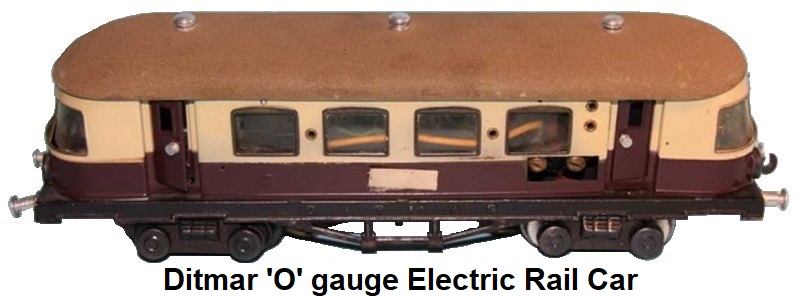 The trains produced were modelled after Austrian and German prototypes. Manufacturing techniques included stamping,
embossing, riveting, spot welding, and die casting. Only 2 steam outline locomotives were made,
but you could choose between electric or clockwork driven models. One loco was a #22,100 2-6-0 and the other was an 0-4-0,
both came with tenders. Ditmar steam outline locomotives were painted black with red painted lines and were fitted with
red painted wheels and driver sets. The boilers were bare metal with a bronze finish. These locomotives were fitted with
cow-catchers as well as buffers, which was a curious configuration. It is believed that the company intended to market
these trains to American consumers, but none were actually ever commercially exported to the United States. An 8-wheeled
powered rail car with a non-powered trailer was also offered in electric or clockwork driven versions. The electric
powered locos all featured a reversing mechanism.
The trains produced were modelled after Austrian and German prototypes. Manufacturing techniques included stamping,
embossing, riveting, spot welding, and die casting. Only 2 steam outline locomotives were made,
but you could choose between electric or clockwork driven models. One loco was a #22,100 2-6-0 and the other was an 0-4-0,
both came with tenders. Ditmar steam outline locomotives were painted black with red painted lines and were fitted with
red painted wheels and driver sets. The boilers were bare metal with a bronze finish. These locomotives were fitted with
cow-catchers as well as buffers, which was a curious configuration. It is believed that the company intended to market
these trains to American consumers, but none were actually ever commercially exported to the United States. An 8-wheeled
powered rail car with a non-powered trailer was also offered in electric or clockwork driven versions. The electric
powered locos all featured a reversing mechanism.
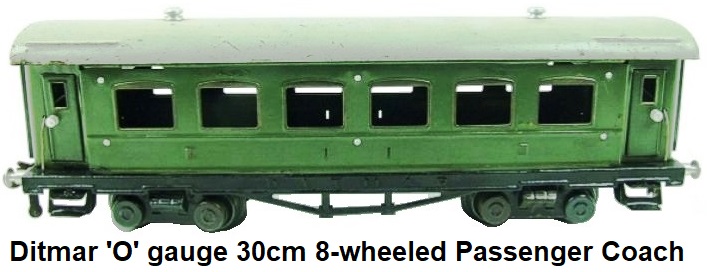
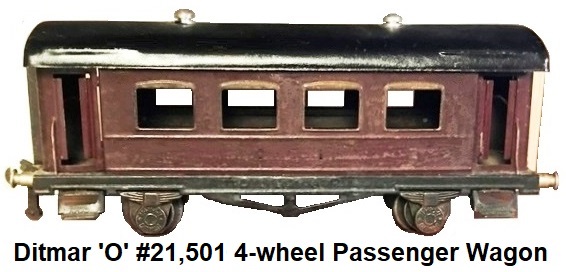

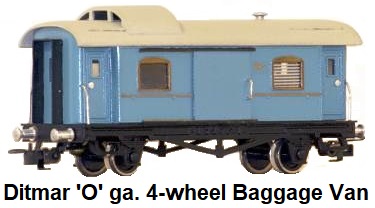 Passenger coaches were made in both 8-wheel bogie versions and 4-wheel versions. The 4-wheel coaches were
23 centimeters long and the bogie coaches were 30 centimeters long. A baggage car in either 4 or 8-wheel was also produced. 4 and 8-wheel freight cars were also made. The 4-wheel cars measured 16 centimeters and the 8-wheel freights were 25
centimeters long. The 8-wheel freight cars included a low and a high-sided gondola, a stake car, a #21,503 box car
and a double lumber car. The 4-wheeled freights included a low and high-sided gondola, a box car, an unusual tank car,
a tarpaulin covered gondola, a cement car, a side-dumping car, a stake car with lumber and a milk transport car. Cars
were finished in high gloss lacquer, primarily brown, but some were also painted green and some were painted blue or
white. The name Ditmar appears embossed on the ends of many of the cars.
Passenger coaches were made in both 8-wheel bogie versions and 4-wheel versions. The 4-wheel coaches were
23 centimeters long and the bogie coaches were 30 centimeters long. A baggage car in either 4 or 8-wheel was also produced. 4 and 8-wheel freight cars were also made. The 4-wheel cars measured 16 centimeters and the 8-wheel freights were 25
centimeters long. The 8-wheel freight cars included a low and a high-sided gondola, a stake car, a #21,503 box car
and a double lumber car. The 4-wheeled freights included a low and high-sided gondola, a box car, an unusual tank car,
a tarpaulin covered gondola, a cement car, a side-dumping car, a stake car with lumber and a milk transport car. Cars
were finished in high gloss lacquer, primarily brown, but some were also painted green and some were painted blue or
white. The name Ditmar appears embossed on the ends of many of the cars.
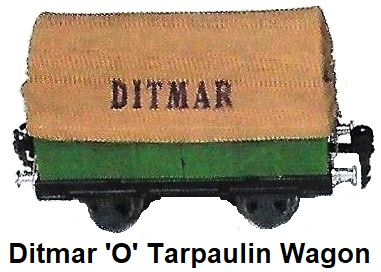
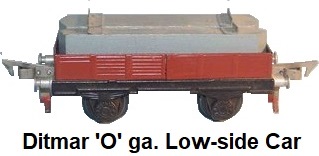
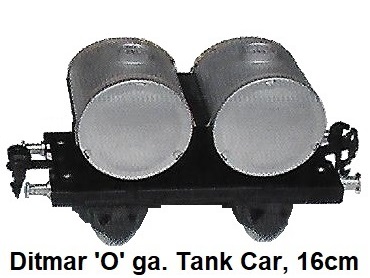

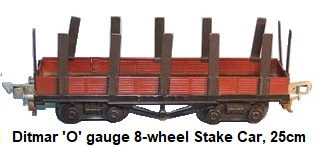

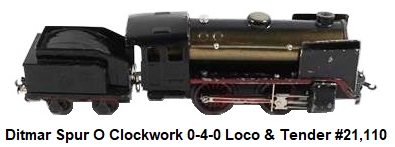 The Ditmar train catalogs issued in the 1950's featured 12 pages of trains, track, trackside
accessories, switches, and a transformer. Track was available for electric or clockwork. Turnouts and crossovers were
also offered. The accessories sold included a buffer stop, a remote controlled uncoupling track, operating lighted signals,
2 types of street lamps, and crossing gates. In addition to the transformer, there were various types of control buttons
and passenger car lighting sets that could be clipped into the cars.
The Ditmar train catalogs issued in the 1950's featured 12 pages of trains, track, trackside
accessories, switches, and a transformer. Track was available for electric or clockwork. Turnouts and crossovers were
also offered. The accessories sold included a buffer stop, a remote controlled uncoupling track, operating lighted signals,
2 types of street lamps, and crossing gates. In addition to the transformer, there were various types of control buttons
and passenger car lighting sets that could be clipped into the cars.
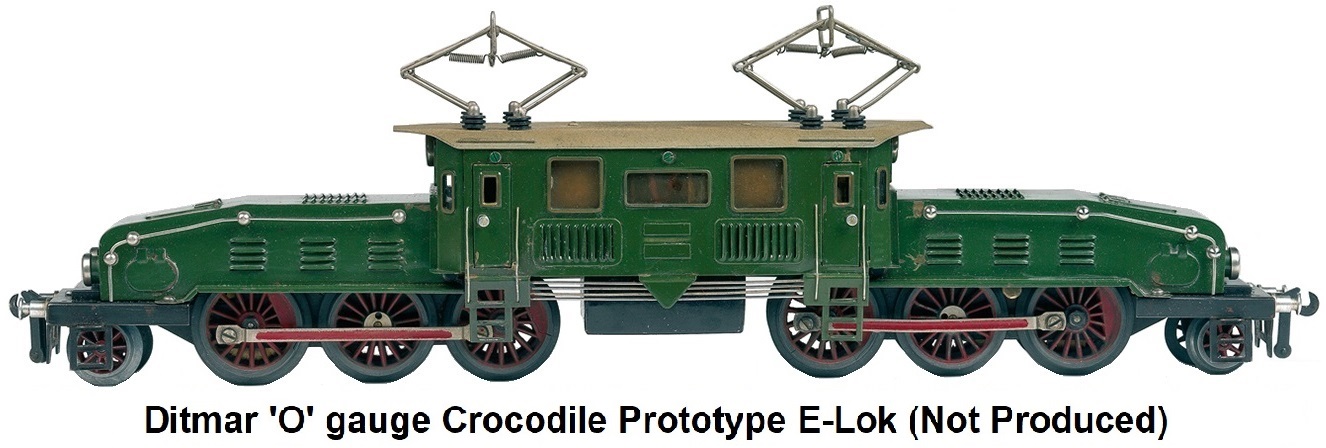 Additional cars were planned to be made, but manufacturing ceased before they were issued. These included an
8-wheeled tank car, a 4 and an 8-wheeled hopper and a crane car. Only handmade samples of these cars were ever produced.
There were also plans to produce a 2 and a 3-unit articulated diesel rail car, but none were ever created. A crocodile
style electric freight locomotive reached the handmade sample stage, but never went into production.
Additional cars were planned to be made, but manufacturing ceased before they were issued. These included an
8-wheeled tank car, a 4 and an 8-wheeled hopper and a crane car. Only handmade samples of these cars were ever produced.
There were also plans to produce a 2 and a 3-unit articulated diesel rail car, but none were ever created. A crocodile
style electric freight locomotive reached the handmade sample stage, but never went into production.
Ditmar trains are easily identifiable by the unique embossed journal boxes over each wheel axle.
These appear as round, dough-nut shaped stampings with the name 'Ditmar' in the center. Early production featured
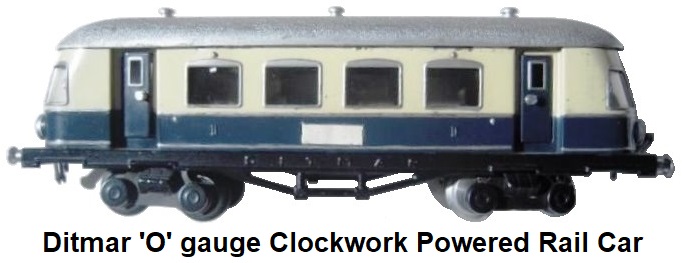 manually operated hook and link couplers, but an automatic coupling/uncoupling system was outfitted on the trains
manufactured later on.
manually operated hook and link couplers, but an automatic coupling/uncoupling system was outfitted on the trains
manufactured later on.
Because Ditmar trains were produced for only a 7 year span, and mostly distributed in Austria,
they are very difficult to find outside of that area. They are considered to be rare and collectible, and
can sometimes be located for sale in small antique shops or at auction houses in Austria. When they are discovered,
they garner decent prices, especially if found in good condition, in complete sets with boxes and all operating components.
